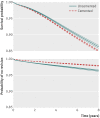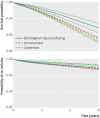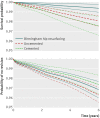Mortality and implant revision rates of hip arthroplasty in patients with osteoarthritis: registry based cohort study - PubMed (original) (raw)
Mortality and implant revision rates of hip arthroplasty in patients with osteoarthritis: registry based cohort study
D J W McMinn et al. BMJ. 2012.
Abstract
Objectives: To examine mortality and revision rates among patients with osteoarthritis undergoing hip arthroplasty and to compare these rates between patients undergoing cemented or uncemented procedures and to compare outcomes between men undergoing stemmed total hip replacements and Birmingham hip resurfacing.
Design: Cohort study.
Setting: National Joint Registry.
Population: About 275,000 patient records.
Main outcome measures: Hip arthroplasty procedures were linked to the time to any subsequent mortality or revision (implant failure). Flexible parametric survival analysis methods were used to analyse time to mortality and also time to revision. Comparisons between procedure groups were adjusted for age, sex, American Society of Anesthesiologists (ASA) grade, and complexity.
Results: As there were large baseline differences in the characteristics of patients receiving cemented, uncemented, or resurfacing procedures, unadjusted comparisons are inappropriate. Multivariable survival analyses identified a higher mortality rate for patients undergoing cemented compared with uncemented total hip replacement (adjusted hazard ratio 1.11, 95% confidence interval 1.07 to 1.16); conversely, there was a lower revision rate with cemented procedures (0.53, 0.50 to 0.57). These translate to small predicted differences in population averaged absolute survival probability at all time points. For example, compared with the uncemented group, at eight years after surgery the predicted probability of death in the cemented group was 0.013 higher (0.007 to 0.019) and the predicted probability of revision was 0.015 lower (0.012 to 0.017). In multivariable analyses restricted to men, there was a higher mortality rate in the cemented group and the uncemented group compared with the Birmingham hip resurfacing group. In terms of revision, the Birmingham hip resurfacings had a similar revision rate to uncemented total hip replacements. Both uncemented total hip replacements and Birmingham hip resurfacings had a higher revision rate than cemented total hip replacements.
Conclusions: There is a small but significant increased risk of revision with uncemented rather than cemented total hip replacement, and a small but significant increased risk of death with cemented procedures. It is not known whether these are causal relations or caused by residual confounding. Compared with uncemented and cemented total hip replacements, Birmingham hip resurfacing has a significantly lower risk of death in men of all ages. Previously, only adjusted analyses of hip implant revision rates have been used to recommend and justify use of cheaper cemented total hip implants. Our investigations additionally consider mortality rates and suggest a potentially higher mortality rate with cemented total hip replacements, which merits further investigation.
Conflict of interest statement
Competing interests: All authors have completed the ICMJE uniform disclosure form at www.icmje.org/coi\_disclosure.pdf (available on request from the corresponding author) and declare: DJWMcM and RBCT were designers of Birmingham hip resurfacing and were shareholders in Midland Medical Technologies before the company was sold to Smith and Nephew in 2004. DJWMcM is an unpaid consultant to Smith and Nephew Orthopaedics UK. The McMinn Centre receives institutional research funding for specific research projects but no funding has been received for the research or preparation of this manuscript.
Figures
Fig 1 Population averaged (adjusted) survival curves (with 95% confidence intervals shown by dashed lines) for cemented versus uncemented with mortality or revision as endpoint
Fig 2 Population averaged (adjusted) survival curves (with 95% confidence intervals shown by dashed lines) for men comparing cemented, uncemented, and Birmingham hip resurfacing patients, with mortality or revision as endpoint
Fig 3 Population averaged (adjusted) survival curves for men aged under 55 comparing cemented, uncemented, and Birmingham hip resurfacing patients, with mortality or revision as endpoint
Fig 4 Transoesophageal echocardiogram in patient after cemented total hip replacement, showing fat and marrow echogenic material in right atrium and right ventricle. No echogenic material in left atrium or left ventricle, indicating that debris has been filtered in pulmonary vasculature
Comment in
- Paper's conclusions will only cause confusion.
Jameson SS, Baker P, Deehan D, Reed M, Mason J. Jameson SS, et al. BMJ. 2012 Oct 30;345:e7005. doi: 10.1136/bmj.e7005. BMJ. 2012. PMID: 23112052 No abstract available. - Excess mortality can be explained by case mix selection.
Breusch SJ, Howie CR. Breusch SJ, et al. BMJ. 2012 Oct 30;345:e7137. doi: 10.1136/bmj.e7137. BMJ. 2012. PMID: 23112053 No abstract available. - Caution is needed in interpreting results.
Dalgleish S, Finlayson D. Dalgleish S, et al. BMJ. 2012 Oct 30;345:e7144. doi: 10.1136/bmj.e7144. BMJ. 2012. PMID: 23112054 No abstract available. - Clarification from the National Joint Registry.
MacGregor AJ. MacGregor AJ. BMJ. 2012 Oct 30;345:e7199. doi: 10.1136/bmj.e7199. BMJ. 2012. PMID: 23112055 No abstract available. - Response to two recent BMJ papers on mortality after hip replacement: comparative modelling study.
Kandala NB, Connock M, Pulikottil-Jacob R, Mistry H, Sutcliffe P, Costa M, Clarke A. Kandala NB, et al. BMJ. 2014 Feb 19;348:g1506. doi: 10.1136/bmj.g1506. BMJ. 2014. PMID: 24554171 No abstract available.
Similar articles
- [Influence of the Type of Hip-Component Fixation and Age of Patients on Mid-Term Revision Rate of Total Hip Replacement].
Kubinec V. Kubinec V. Acta Chir Orthop Traumatol Cech. 2018;85(1):46-53. Acta Chir Orthop Traumatol Cech. 2018. PMID: 30257769 Slovak. - Association between fixation technique and revision risk in total hip arthroplasty patients younger than 55 years of age. Results from the Nordic Arthroplasty Register Association.
Pedersen AB, Mehnert F, Havelin LI, Furnes O, Herberts P, Kärrholm J, Garellick G, Mäkela K, Eskelinen A, Overgaard S. Pedersen AB, et al. Osteoarthritis Cartilage. 2014 May;22(5):659-67. doi: 10.1016/j.joca.2014.03.005. Epub 2014 Mar 13. Osteoarthritis Cartilage. 2014. PMID: 24631923 - Systematic review of the outcome of cemented versus uncemented total hip arthroplasty following pelvic irradiation.
Walters S, Prasad A, Guevel B, Sarraf KM, Achan P, Dawson-Bowling S, Millington S, Hanna SA. Walters S, et al. Musculoskelet Surg. 2019 Dec;103(3):221-230. doi: 10.1007/s12306-019-00597-z. Epub 2019 Apr 1. Musculoskelet Surg. 2019. PMID: 30937859
Cited by
- The future role of metal-on-metal hip resurfacing.
Matharu GS, Pandit HG, Murray DW, Treacy RB. Matharu GS, et al. Int Orthop. 2015 Oct;39(10):2031-6. doi: 10.1007/s00264-015-2692-z. Epub 2015 Feb 24. Int Orthop. 2015. PMID: 25708400 Review. - Cementless short-stem total hip arthroplasty in the elderly patient - is it a safe option?: a prospective multicentre observational study.
Gkagkalis G, Goetti P, Mai S, Meinecke I, Helmy N, Bosson D, Kutzner KP. Gkagkalis G, et al. BMC Geriatr. 2019 Apr 17;19(1):112. doi: 10.1186/s12877-019-1123-1. BMC Geriatr. 2019. PMID: 30995903 Free PMC article. Clinical Trial. - Is Cemented or Cementless Femoral Stem Fixation More Durable in Patients Older Than 75 Years of Age? A Comparison of the Best-performing Stems.
Tanzer M, Graves SE, Peng A, Shimmin AJ. Tanzer M, et al. Clin Orthop Relat Res. 2018 Jul;476(7):1428-1437. doi: 10.1097/01.blo.0000533621.57561.a4. Clin Orthop Relat Res. 2018. PMID: 29683803 Free PMC article. - Evidence-base for aspirin as venous thromboembolic prophylaxis following joint replacement.
Jameson SS, Baker PN, Deehan DJ, Port A, Reed MR. Jameson SS, et al. Bone Joint Res. 2014 May;3(5):146-9. doi: 10.1302/2046-3758.35.2000225. Bone Joint Res. 2014. PMID: 24837005 Free PMC article. - Cemented, cementless, and hybrid prostheses for total hip replacement: cost effectiveness analysis.
Pennington M, Grieve R, Sekhon JS, Gregg P, Black N, van der Meulen JH. Pennington M, et al. BMJ. 2013 Feb 27;346:f1026. doi: 10.1136/bmj.f1026. BMJ. 2013. PMID: 23447338 Free PMC article.
References
- Charnley J. Low friction arthroplasty of the hip Berlin. Springer-Verlag, 1979.
- Wroblewski BM, Siney PD, Fleming PA. Charnley low-friction arthroplasty. Survival patterns to 38 years. J Bone Joint Surg Br 2007;89:1015-8. - PubMed
- Treacy RB, McBryde CW, Shears E, Pynsent PB. Birmingham hip resurfacing: a minimum follow-up of ten years. J Bone Joint Surg Br 2011;93:27-33. - PubMed
Publication types
MeSH terms
LinkOut - more resources
Full Text Sources
Medical
Research Materials



